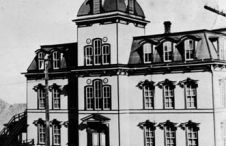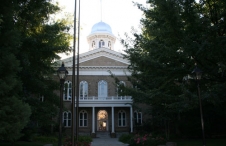Alice Maud Hartley
Alice Maud Hartley (1864-1908) is a tragic figure in the annals of Nevada art. She was born in England, and arrived in Reno in 1892. It was then that her life became entangled with Nevada state senator Murray D. Foley. On July 26, 1894, following a tense argument, she fatally shot the senator. A high-profile trial ensued, and the artist was sent to the Nevada State Prison where she made modest sketches of sights around the prison grounds.
A lone drawing by Alice Maud Hartley resides in the collection of the Nevada Historical Society in Reno. This colored pencil study, executed in 1896, depicts a tree-lined road leading up to the Nevada State Prison in Carson City. Hartley's careful treatment of the hand-hewn rock walls seems more important than any attempt by the artist to people the scene.
Hartley's early years are sketchy. An art student in her native England, and in ateliers in Rome, the widowed Hartley lived briefly in Virginia City where she derived a comfortable income painting portraits and offering art instruction to ladies of the town. When she reached Reno in 1893, the artist rented a studio on the top floor of the new Bank of Nevada building—intending to support herself by the same means.
Hartley was described in the Reno press at the time as "fashionable," and possessing a "rare beauty," attributes that undoubtedly attracted the married senator Foley. The coverage of the murder trial only seemed to blur the true nature of their relationship. Hartley's defense contended that Foley had forced himself upon her. The extent of his attentions was obvious when it became apparent that Hartley was expecting his child.
The six-day trial ended in a conviction. Hartley, and her infant son, served eighteen months of an eleven-year sentence. After being released, she moved on to San Francisco, and died in Denver in 1908.
Hartley exhibited several portraits in a show at the Mark Hopkins Institute of Art in San Francisco. A critic at the time suggested that these paintings "attracted considerable attention." Hartley's prison sketchbooks offer the only known graphic record of her presence in Nevada.



